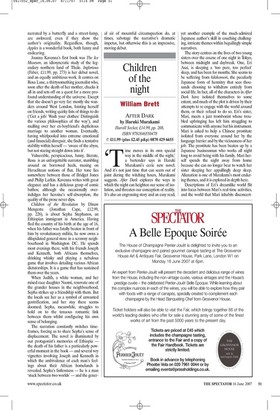Children of the night
William Brett AFTER DARK by Haruki Murakami Harvill Secker, £14.99, pp. 208, ISBN 9781846550478 © £11.99 (plus £2.45 p&p) 0870 429 6655 ime moves in its own special way in the middle of the night,' a bartender says in Haruki Murakami's eerie new novel. And it's not just time that can seem out of joint during the witching hours, Murakami suggests. After Dark explores the ways in which the night can heighten our sense of isolation, and threaten our conception of reality. It's also an engrossing story and an easy read, yet another example of the much-admired Japanese author's skill in couching challenging, intricate themes within beguilingly simple narratives.
The story centres on the lives of two young sisters over the course of one night in Tokyo, between midnight and daybreak. One, Ed Asai, is sleeping a 'too pure, too perfect' sleep, and has been for months. She seems to be suffering from hikikommi, the peculiarly Japanese form of hermitry that sees thousands choosing to withdraw entirely from social life. In fact, all of the characters inAfter Dark have isolated themselves to some extent, and much of the plot is driven by their attempts to re-engage with the world around them, or their refusal to do so. En's sister, Mai, meets a jazz trombonist whose troubled upbringing has left him struggling to communicate with anyone but his instrument. Mai is asked to help a Chinese prostitute isolated from everyone around her by the language barrier and by the viciousness of her job. The prostitute has been beaten up by a Japanese businessman who works all night long to avoid being with his family. Mari herself spends the night away from home because she can no longer bear to watch her sister sleeping her appallingly deep sleep. Alienation is one of Murakami's most enduring themes, and it is explored in depth here.
Descriptions of Eri's dreamlike world flit into focus between Mai's real-time activities, and the world that Mai inhabits disconcertingly echoes En's subconscious life. Murakami is living up to his reputation as a master of the surreal. As En i is transported somehow into an abandoned warehouse via the TV screen in her room, Man's image in the bathroom mirror of a seedy Tokyo nightclub remains even after she has gone. And the violent businessman who beats up the Chinese prostitute is unnervingly similar to a man that appears, faceless, in En's quietly horrific dream. The ubiquity of screens (mirrors, TVs, even psychological layers'), and the strange ways in which they are crossed or inverted, reflects Murakami's concern with our desire to break out from subjective consciousness, and our inability to do so without the help of dreams, surrealism or the oddness of night.
All this may sound a little heavy, overwrought, even pretentious. But Murakami writes with such elegance that the reader receives his ideas more by osmosis than by intellectual elbow grease. Much of the novel has the bare-boned, objective style of a screenplay, complete with present tense, widespread dialogue and even suggestions that the reader's 'eye' is a camera's viewpoint (although this breaks a cast-iron screenwriter's adage — never mention the camera). This technique certainly has a bearing on the story's themes of alienation and the isolation of consciousness, but Murakami doesn't force it. Instead, he allows the innate simplicity of the screenplay style to carry the narrative's considerable literary weight with a rare grace.
After Dark is the first of Murakami's novels since the enormously popular Norwegian Wood (1987) that looks seriously at the trials of adolescence. The two novels are also similar in their stripped-back style, but here the comparisons end. While Nowegian Wood is laden with sex, rebellion, popular culture and the predominant concerns of the young, After Dark is less intent on being hip. Its lightly worn seriousness marks it out as the work of a mature writer employing his considerable powers to the full.





















































 Previous page
Previous page